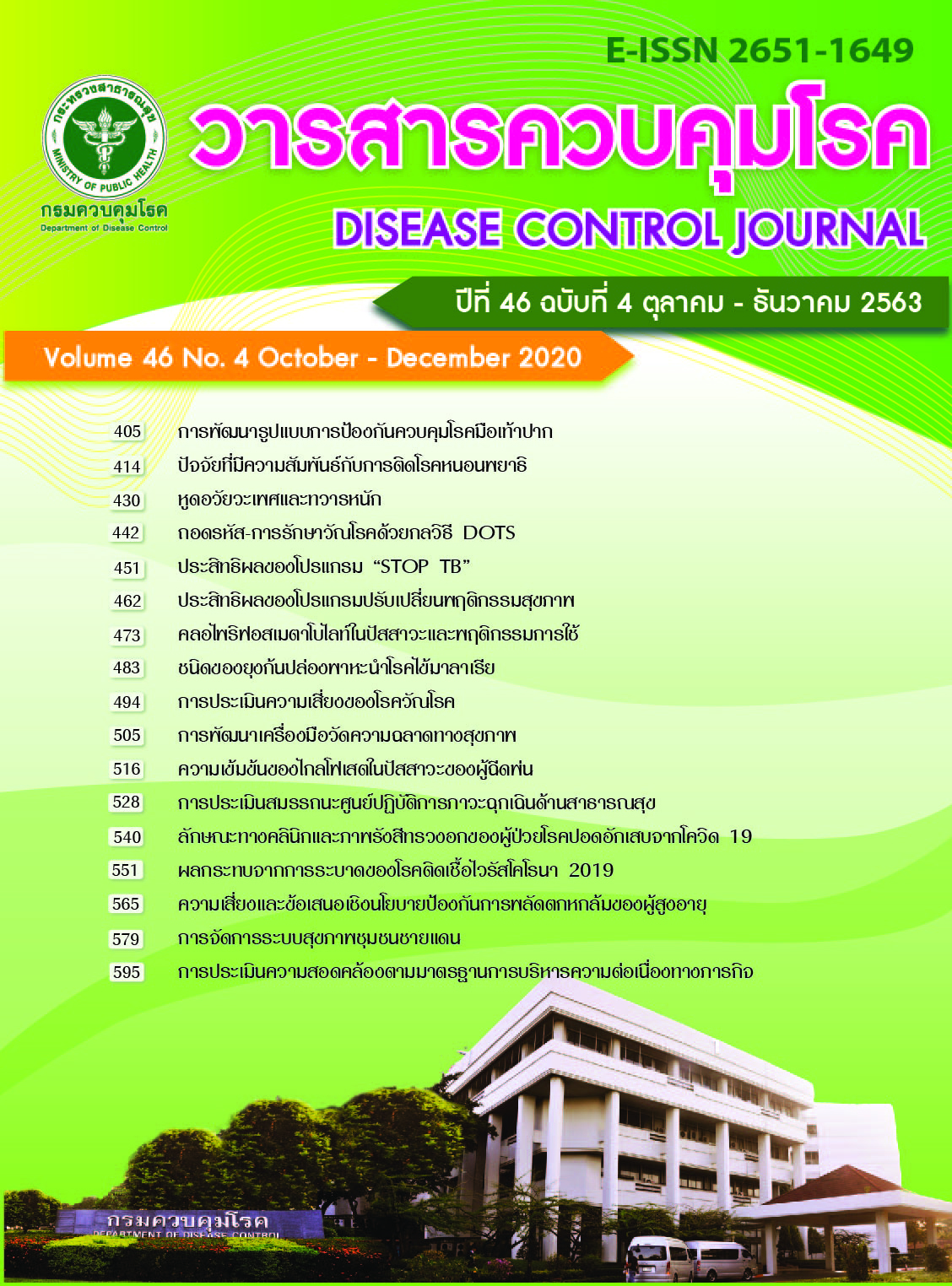Prevalence of anogenital warts, sexual risk behaviors, and clinical manifestations among male patients attending sexually transmitted infections clinic, Bangkok
DOI:
https://doi.org/10.14456/dcj.2020.40Keywords:
Prevalence, Anogenital warts, Sexually transmitted infections clinicAbstract
Anogenital warts (AGW) remains one of the most common sexually transmitted infections STIs) among male patients visiting STIs clinics. AGW is caused by human papillomavirus, in particularly types 6 and 11. The objectives of this study were to (1) estimate the prevalence of AGW among male patients attending the STIs clinic, Department of Disease Control, (2) describe the sexual risk behaviors, and (3) describe the clinical manifestations among male patients diagnosed with AGW. We conducted a retrospective descriptive study using 9,160 medical records from male patients visiting the clinic between October 2010 and September 2015. Descriptive statistics, 95% confidence interval, and chi-square test were employed for data analysis. The findings indicated that the prevalence of AGW among male patients attending the clinic was 11.6% (95%CI = 10.9-12.2). The prevalence of AGW among men who have sex with women (MSW) was 8.0% (95% CI = 7.4-8.7) and among men who have sex with men (MSM) was 21.4% (95% CI = 19.8-23.1). The prevalence among MSW aged 40 years and older was 28.1% (95% CI = 24.4-32.1) and the prevalence among MSM aged 20-24 years was 26.6% (95% CI = 22.9-30.7). Among those male patients diagnosed with AGW, consistent condom use during sexual intercourse in the past 3 months were only 13.6%. Anatomical distribution of AGW found that prepuce was the most common location for AGW in MSW, and rectum was the most common in MSM. Eventually, effective interventions to reduce AGW transmission purposively for male patients attending the STIs clinic are needed, especially young MSM.
Downloads
References
Garland SM, Steben M, Sings HL, James M, Lu S, Railkar R, et al. Natural history of genital warts: analysis of the placebo arm of 2 randomized phase 3 trials of a quadrivalent human papillomavirus (type 6, 11, 16, and 18) vaccine. J Infect Dis. 2009;199(6):805-14.
Karnes JB, Usatine RP. Management of external genital warts. Am Fam Physician. Am Fam Physician. 2014;90(5):312-8.
Centers for Disease Control and Prevention. Sexually transmitted disease surveillance 2013 [Internet]. Atlanta: Centers for Disease Control and Prevention; 2014 Dec [cited 2014 Dec 5]. Available from: https://www.cdc.gov/std/stats/archive/Surv2013-Print.pdf
Lacey CJ, Lowndes CM, Shah KV. Chapter 4: Burden and management of non-cancerous HPV-related conditions: HPV-6/11 disease. Vaccine. 2006;24 Suppl 3:S3/35-41.
Bureau of Epidemiology. Annual epidemiological surveillance report 2015 [Internet]. Nonthaburi: Department of Disease Control (TH); 2015. Sexually transmitted infections: STIs; [cited 2020 Jan 29]. Available from: http://www.boe.moph.go.th/Annual/AESR2015/aesr2558/Part%201/06/stis.pdf (in Thai)
Delany-Moretlwe S, Chikandiwa A, Gibbs J. Human papillomavirus infection and disease in men: Impact of HIV. South Afr J HIV Med. 2013;14(4):183-8.
Repp KK, Nielson CM, Fu R, Schafer S, Lazcano-Ponce E, Salmeron J, et al. Male human papillomavirus prevalence and association with condom use in Brazil, Mexico, and the United States. J Infect Dis 2012;205(8):1287-93.
Giuliano AR, Palefsky JM, Goldstone S, Moreira ED, Penny ME, Aranda C, et al. Efficacy of quadrivalent HPV vaccine against HPV infection and disease in males. N Engl J Med. 2011;364(5):401-11.
Workowski KA, Bolan GA. Sexually transmitted disease treatment guidelines, 2015. MMWR Recomm Rep. 2015 Jun 5;64(RR-03):1-137.
Jiamton S, Leeyaphan C, Maneeprasopchoke P, Omcharoen V. Prevalence and clinical manifestations of male patients with anogenital warts attending a sexually transmitted disease clinic prior HPV vaccine recommendation. Southeast Asian J Trop Med Public Health. 2014;45(6):1337-43.
Ministry of Public Health. The Notification of the Ministry of Public Health B.E. 2559 (2016). Re: Name and presenting symptoms of communicable diseases under surveillance B.E. 2559. Government Gazette. No. 133. Section 128 D (June 3, 2016).
Huang S, Tang W, Zhu Z, Lu H, Tan X, Zhang B, et al. Higher prevalence of sexual transmitted diseases and correlates of genital warts among heterosexual males attending sexually transmitted infection clinics (MSCs) in Jiangmen, China: implication for the up-taking of STD related service. PLoS One [Internet]. 2015 [cited 2020 Jan 29];10(3):e0121814. Available from: https://www.ncbi.nlm.nih.gov/pmc/articles/PMC4374714/
Eloisa L, Mark S, Kyle B, Sarah G, Roxanne K, River P, et al. Prevalence of genital warts among sexually transmitted disease clinic patients-Sexually Transmitted Disease Surveillance Network, United States, January 2010 to December 2011. Sex Transm Dis. 2014;41(2):89-93.
Thienkrua W, van Griensven F, Mock PA, Dunne EF, Raengsakulrach B, Wimonsate W, et al. Young men who have sex with men at high risk for HIV, Bangkok MSM cohort study, Thailand 2006–2014. AIDS Behav. 2018;22(7):2137-46.
Park SJ, Seo J, Ha SH, Jung GW. Prevalence and determinants of high-risk human papillomavirus infection in male genital warts. Korean J Urol. 2014;55(3):207-12.
Larke N, Thomas SL, Dos Santos Silva I, Weiss HA. Male circumcision and human papillomavirus infection in men: a systematic review and meta-analysis. J Infect Dis. 2011;204(9):1375-90.
Downloads
Published
How to Cite
Issue
Section
License
Articles published in the Disease Control Journal are considered as academic work, research or analysis of the personal opinion of the authors, not the opinion of the Thailand Department of Disease Control or editorial team. The authors must be responsible for their articles.






